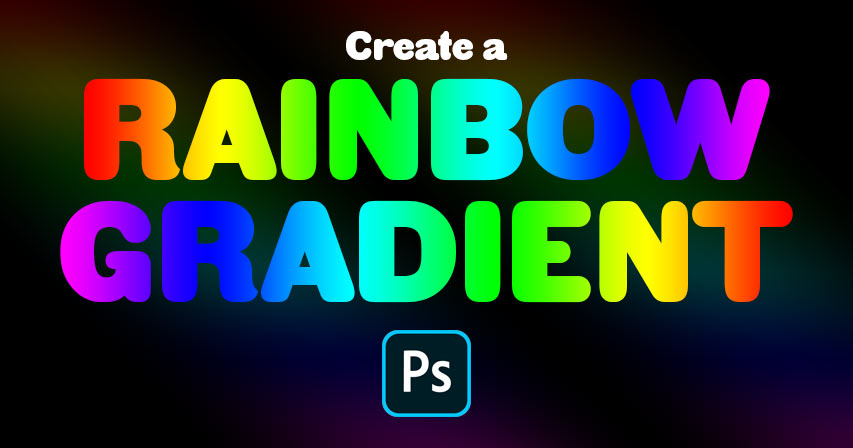
How to Create a Rainbow Gradient in Photoshop

Learn how to create a simple rainbow gradient in Photoshop, how to save it as a rainbow gradient preset, and the fastest way to add your rainbow colors to images, shapes or text! For Photoshop CC 2020.
In this tutorial, I show you how easy it is to create your own rainbow gradient in Photoshop and how to save it as a custom preset. You'll also learn the fastest way to colorize an image with your rainbow colors, and how to add your rainbow gradient to text!
Along the way, we'll be using the Gradients panel which is new as of Photoshop 2020. So for best results, make sure that your copy of Photoshop is up to date. You can get the latest Photoshop version here.
Let's get started!
Creating a new group for your custom gradients
Before we learn how to create the rainbow gradient, let's quickly create a new gradient group to store all of our custom gradients and keep them separate from Photoshop's default gradients. If you have already created a custom group, you can skip this section.
Step 1: Open the Gradients panel
Start by opening the Gradients panel. You'll find it in the same panel group as the Color, Swatches and Patterns panels.
Notice that all of Photoshop's default gradients are divided into groups, like Basics, Blues, Purples, and so on. And each group is represented by a folder:

Step 2: Open the Gradients panel menu
Rather than placing the rainbow gradient into one of these default groups, we'll create our own custom group.
Click on the Gradients panel menu icon in the upper right:
Step 3: Choose "New Gradient Group"
Then choose New Gradient Group from the menu:

Step 4: Name the group "My Gradients"
Name the group "My Gradients", or something similar, and click OK:

Then back in the Gradients panel, scroll down past the default groups and the new group will appear at the bottom, ready to hold our rainbow gradient:

See also: Give someone Rainbow Eye Colors in Photoshop!
How to create a rainbow gradient in Photoshop
Now let's learn how to create the rainbow gradient. As we'll see, it's really just a matter of choosing an existing gradient and then editing the colors.
Step 1: Select the Gradient Tool
Start by selecting the Gradient Tool in the toolbar:

Step 2: Open the Gradient Editor
Then in the Options Bar, click on the gradient swatch to open Photoshop's Gradient Editor.
Make sure you click on the color swatch itself, not the little arrow to the right of the swatch:

Step 3: Select the "Black, White" gradient
In the Presets section of the Gradient Editor, twirl open the Basics folder and choose the Black, White gradient by clicking on its thumbnail. This is the gradient we'll start with:

Step 4: Change the color black to red
Then go down to the gradient preview bar in the lower half of the Gradient Editor.
Click on the black color stop below the left side of the preview bar to select it, and then click on the color swatch to change the color:

In the Color Picker, choose red by setting the R (Red) value to 255, and leaving both the G (Green) and B (Blue) values at 0. Then click OK to close the Color Picker:

Step 5: Set the location of red to 0%
Back in the Gradient Editor, make sure the Location value for red is set to 0%.
And we now have the first color of our rainbow:

Step 6: Add a new color stop and choose yellow
Next, add a new color stop to the gradient by clicking in a blank area to the right of the red color stop.
Don't worry about where exactly you click. We'll set the location for the color stop in a moment:

Then click on the color swatch to change the color:

In the Color Picker, choose yellow by leaving the R value at 255 and changing the G value to 255. Leave the B value at 0 and click OK:

Step 7: Set yellow's location to 20%
And then back in the Gradient Editor, set the Location of yellow to 20%. Two colors down, four to go:

Step 8: Add another color stop and choose green
Next we'll add green. Click to the right of the yellow color stop to add a new color:

Then click on the color swatch:

And in the Color Picker, choose green by setting R to 0, and leaving G at 255 and B at 0. Then click OK:

Step 9: Set green's location to 40%
Set the Location of green to 40%:

Step 10: Add another color step and choose cyan
The next color we need for our rainbow gradient is cyan.
Click to the right of the green color stop to add a new color:

Then click the color swatch:

And in the Color Picker, leave R at 0 and G at 255, but change B to 255:

Click OK to close the Color Picker, and then set cyan's Location to 60%:

Step 11: Add a new color stop and choose blue
We have one more color stop to add, and then we'll edit the white color stop.
Click to the right of the cyan stop to add a new color:

Then click on the color swatch:

And in the Color Picker, choose blue by leaving R at 0, changing G to 0 and leaving B at 255:

Step 12: Set blue's location to 80%
Click OK to close the Color Picker, and then set the Location of blue to 80%:

Step 13: Change the color white to magenta
The last color we need for our rainbow gradient is magenta.
Click on the white color stop below the far right of the gradient preview bar, and then click on the color swatch:

In the Color Picker, choose magenta by changing R to 255 and leaving G at 0 and B at 255:

Step 14: Set magenta's location to 100%
And finally, make sure the Location value for magenta is at 100%.
And we now have our rainbow gradient:

How to save the rainbow gradient as a preset
So now that we've created the rainbow gradient, let's save it as a gradient preset. For this part, we'll need the custom gradient group that we made back in the first part of the tutorial.
Step 1: Select your custom gradient group
Still in the Gradient Editor, select your custom group from the Presets area:

Step 2: Name the gradient "Rainbow"
Change the name of the gradient from "Custom" to "Rainbow":

Step 3: Click "New"
And then to save the gradient as a preset, click the New button:

Back in the Presets area, your rainbow gradient appears as a thumbnail in your custom group, ready to be selected whenever you need it. At this point, you can click OK to close the Gradient Editor.
Up next, I'll show you the fastest way to apply the rainbow gradient to an image or to text:

How to apply the rainbow gradient to an image
As of Photoshop CC 2020, the easiest way to apply the rainbow gradient to an image, a shape or text is by dragging and dropping it from the Gradients panel.
Here's an image I've opened in Photoshop that I downloaded from Adobe Stock:

Step 1: Open the Gradients panel
To colorize an image with the rainbow gradient, open the Gradients panel:

Step 2: Drag the rainbow gradient onto the image
Twirl open the group that holds your rainbow gradient and select it by clicking on its thumbnail:

Then simply drag the gradient from the Gradients panel onto your image:

The gradient temporarily blocks the image from view.
I'll show you how to change the direction of the colors in a moment:

Step 3: Change the Gradient fill layer's blend mode
In the Layers panel, the gradient appears on its own Gradient fill layer above the image.
To blend the rainbow colors into the image, change the fill layer's blend mode to either Color, Overlay or Soft Light. Each mode will give you a different result, so choose the one that looks best:

Step 4: Lower the layer opacity
If the colors are too intense, lower the Opacity of the fill layer. I'll lower mine to 40 percent:

And here's my result with the rainbow gradient set to the Overlay blend mode at 40 percent opacity:

Step 5: Change the gradient's direction
To change the direction of the gradient colors, double-click on the Gradient fill layer's color swatch in the Layers panel:

This opens the Gradient Fill dialog box where you can edit various options.
To simply reverse the gradient colors, select the Reverse option. Or enter a new Angle value to change the gradient's direction. For example, to display the gradient from left to right, set the angle to 0°. Or for a diagonal gradient, try 45°.
Click OK when you're done to close the dialog box:

Related: Learn ALL the new ways to add gradients in Photoshop!
How to add the rainbow gradient to text
It's just as easy to apply the rainbow gradient to text. But there's a difference in how we edit the gradient options:

Step 1: Drag the rainbow gradient onto the text
Click and drag the gradient from the Gradients panel onto the text in your document.
Make sure you drop it directly on one of the letters, not on the background:

By default, the initial result will look like this, with the gradient running vertically through the letters:

Step 2: Edit the Gradient Overlay layer effect
A moment ago, we saw that Photoshop applies gradients as Gradient fill layers when we drop them onto an image. But when we drop a gradient onto text, the gradient is applied as a Gradient Overlay layer effect.
To change the gradient's direction, double-click on the words "Gradient Overlay" below the type layer in the Layers panel:

Instead of opening the Gradient Fill dialog box, Photoshop opens the Layer Style dialog box where we find the same Reverse and Angle options.
To change the direction from vertical to horizontal, set the Angle to 0°:

Click OK to close the Layer Style dialog box.
And the rainbow gradient now runs through the text from left to right:

Where to go next
And there we have it! That's how to create a rainbow gradient, how to save the gradient as a preset, and how to add the rainbow colors to an image or text in Photoshop!
Check out our Photoshop Basics section for more tutorials. And don't forget, all of our Photoshop tutorials are available to download as PDFs!